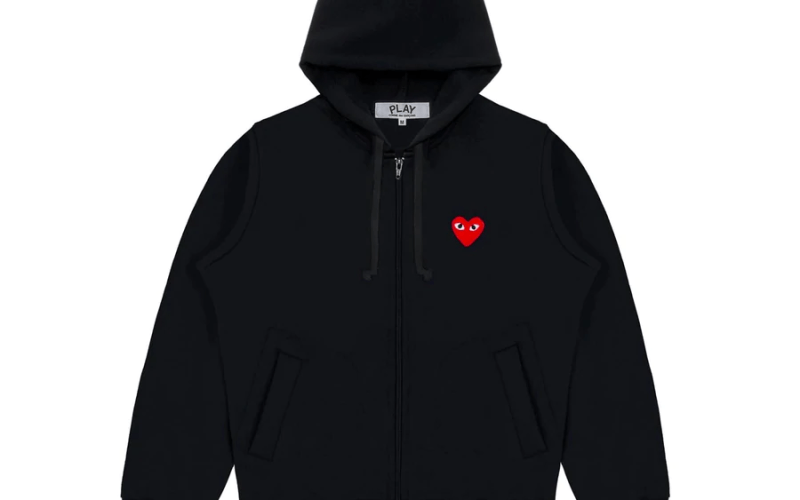Introduction
In the ever-evolving world of fashion, few names have managed to disrupt norms and redefine aesthetics as consistently as Comme des Garçons. Founded by Rei Kawakubo, this Japanese brand is synonymous with innovation, rebellion, and a powerful departure from traditional design codes. From deconstructed tailoring to high-profile sneaker collaborations, Comme des Garçons (often abbreviated as CDG) has carved a space where art meets fashion unapologetically and with lasting impact.
The Origin Story: Rei Kawakubo and the Birth of Comme Des Garçons
Comme des Garçons was founded in Tokyo in 1969 by Rei Kawakubo, a self-taught designer who previously worked in advertising and textile design. The name French for “like the boys” already hinted at a rejection of conventional femininity. From the start, Kawakubo challenged traditional silhouettes and ideas of beauty, presenting garments that were intentionally asymmetric, oversized, or even “unfinished.”
The brand debuted in Paris in 1981 with a collection that shocked critics. Models walked the runway in black, shapeless garments that defied fashion’s norms of glamour and sex appeal. The press dubbed it “Hiroshima chic,” yet the disruptive aesthetic resonated with a generation tired of polished perfection. What seemed controversial at the time is now recognized as a landmark moment in the history of fashion.
The CDG Aesthetic: Deconstruction and Defiance
At the heart of Comme des Garçons’ identity is a willingness to defy expectations. Rather than chase trends, Kawakubo creates fashion as art using the runway to explore ideas, emotions, and social commentary. Each season, CDG collections arrive like conceptual installations, where clothing is sculpted rather than sewn.
Garments are often deconstructed, stitched inside-out, or layered in ways that obscure the human form. There’s an embrace of imperfection, irregularity, and non-conformity. While this approach can be intellectually demanding, it has made the label a cult favorite among those who view fashion as more than just clothing — but as a statement.
Beyond the runway, CDG also extends its aesthetic through numerous sub-labels, including Comme des Garçons Play, which offers a more accessible range of clothing marked by its iconic heart logo designed by Polish artist Filip Pagowski.
Comme Des Garçons in the Sneaker World
In recent years, CDG Hoodie has played a pivotal role in the evolution of sneaker culture. The brand’s partnerships with major footwear giants like Nike, Converse, New Balance, and ASICS have redefined the limits of sneaker design. Rather than simply branding a classic silhouette, CDG often reinterprets sneakers through its avant-garde lens.
The Comme des Garçons x Converse Chuck Taylor is perhaps the most recognizable of these collaborations. Featuring the heart-with-eyes logo, the design adds a playful yet rebellious twist to a heritage sneaker, making it a staple in streetwear wardrobes worldwide.
Other notable releases include the CDG x Nike Air Max 95, which experimented with layering and transparency, and the CDG x Nike Foamposite, known for its molded, futuristic design. Even the New Balance 550, originally a ‘90s basketball shoe, was reimagined by CDG with a minimalist, monochrome color scheme — a signature of the brand’s understated cool.
These collaborations demonstrate how CDG seamlessly blends high fashion with street culture, offering wearable pieces that still carry an artistic edge. They also highlight the growing importance of designer-sneaker partnerships in contemporary fashion.
Comme Des Garçons PLAY: Where Streetwear Meets Art
Comme des Garçons PLAY is arguably the most commercially successful arm of the CDG universe. Launched in 2002, PLAY targets a younger, global audience with more casual, wearable pieces such as t-shirts, hoodies, and cardigans. The standout feature, of course, is the now-iconic heart logo — expressive yet simple, it represents a softer, more playful side of the otherwise cerebral brand.
While critics once questioned whether PLAY diluted the radical edge of CDG Shirt high-fashion line, its success cannot be denied. It has allowed the brand to expand its reach, especially among sneaker enthusiasts and streetwear fans who value subtle design cues with strong brand identity.
PLAY’s collaborations with Converse and Nike continue to be bestsellers, often selling out upon release. The line sits comfortably at the intersection of hype culture and timeless design — proving that commercial success doesn’t have to compromise creative integrity.
The Importance of Comme Des Garçons in Contemporary Fashion
More than just a brand, Comme des Garçons functions as a platform for innovation. Each collection is an invitation to think differently — about fashion, beauty, gender, and identity. Rei Kawakubo’s refusal to explain her collections, often leaving them untitled or accompanied by abstract themes, demands that viewers interpret the work for themselves.
Her influence can be felt across the fashion spectrum. Designers like Junya Watanabe and Kei Ninomiya, both CDG protégés, continue the brand’s legacy of experimentation through their own labels. In the West, Kawakubo’s impact has been acknowledged by the Metropolitan Museum of Art’s 2017 exhibition Rei Kawakubo/Comme des Garçons: Art of the In-Between — a rare honor, as she was the first living designer since Yves Saint Laurent to receive such recognition.
In the world of sneakers, CDG’s collaborations have set the tone for what high-end streetwear can look like. The brand proves that function and fashion, comfort and concept, can co-exist in a single pair of shoes.
Cultural Crossovers and Future Relevance
Comme des Garçons’ reach extends beyond fashion and sneakers. The brand has collaborated with artists, musicians, architects, and even perfume houses. Its line of fragrances, launched under Comme des Garçons Parfums, includes scents that challenge the olfactory norm — from the metallic “Odeur 53” to the smoky “Black.”
Retail-wise, CDG also revolutionized the shopping experience. Its Dover Street Market concept stores, founded in 2004, blend fashion, art, and architecture in an immersive retail environment. Each location serves as a curated universe where CDG collections sit alongside cutting-edge designers from around the world.
This multi-disciplinary approach ensures that CDG remains culturally relevant. It’s not simply responding to trends but creating a world where fashion serves as a platform for expression, critique, and innovation.
Why Comme Des Garçons Matters to Sneakerheads
For sneaker enthusiasts, CDG offers more than just hype or resale value. It provides a connection to a broader cultural movement one that values creativity, risk-taking, and authenticity. Whether it’s a classic Chuck Taylor with a heart logo or an obscure Nike silhouette reimagined with architectural flair, CDG sneakers offer wearers a piece of fashion history.
They’re not about showing off the loudest flex but about appreciating design language, brand storytelling, and the fusion of art and function. In a landscape flooded with predictable collaborations, Comme des Garçons consistently brings something unexpected to the table.
Conclusion: The Legacy of Comme Des Garçons
Comme des Garçons is more than a brand it’s a philosophy. One rooted in defiance, abstraction, and relentless creativity. From Rei Kawakubo’s groundbreaking designs to the brand’s cultural crossover into sneakers and streetwear, CDG continues to redefine what fashion can be.
For those immersed in fashion or sneaker culture, embracing Comme des Garçons is like stepping into a world where boundaries don’t exist — only possibilities. Whether you’re drawn to the intellectual appeal of its runway shows or the street-smart design of its sneaker collabs, one thing is certain: CDG will always stay one step ahead, challenging norms and reshaping style with every step.












